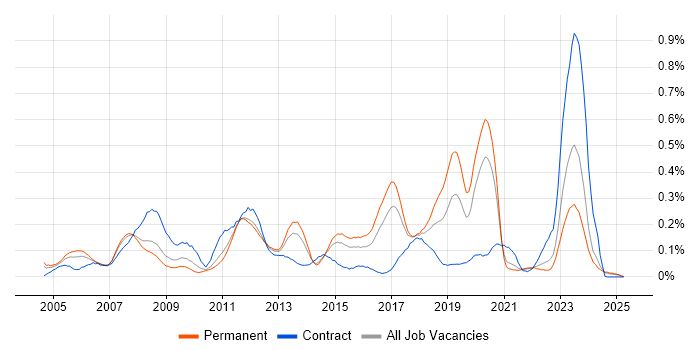SAP Materials Management (MM)
England > Yorkshire
The table below provides summary statistics for permanent job vacancies advertised in Yorkshire requiring SAP MM skills. It includes a benchmarking guide to the annual salaries offered in vacancies that cited SAP MM over the 6 months leading up to 9 May 2025, comparing them to the same period in the previous two years.
| 6 months to 9 May 2025 |
Same period 2024 | Same period 2023 | |
|---|---|---|---|
| Rank | - | 211 | 298 |
| Rank change year-on-year | - | +87 | -21 |
| Permanent jobs citing SAP MM | 0 | 4 | 7 |
| As % of all permanent jobs advertised in Yorkshire | - | 0.069% | 0.086% |
| As % of the Business Applications category | - | 1.96% | 1.59% |
| Number of salaries quoted | 0 | 2 | 5 |
| 10th Percentile | - | £38,901 | - |
| 25th Percentile | - | £38,918 | £56,250 |
| Median annual salary (50th Percentile) | - | £40,841 | £60,000 |
| Median % change year-on-year | - | -31.93% | +36.36% |
| 75th Percentile | - | £42,868 | £62,500 |
| 90th Percentile | - | £42,947 | - |
| England median annual salary | £85,000 | £70,000 | £60,000 |
| % change year-on-year | +21.43% | +16.67% | +8.11% |
All Business Application Skills
Yorkshire
SAP MM falls under the Business Applications category. For comparison with the information above, the following table provides summary statistics for all permanent job vacancies requiring business application skills in Yorkshire.
| Permanent vacancies with a requirement for business application skills | 88 | 204 | 439 |
| As % of all permanent jobs advertised in Yorkshire | 3.18% | 3.52% | 5.41% |
| Number of salaries quoted | 72 | 161 | 243 |
| 10th Percentile | £29,450 | £29,750 | £40,000 |
| 25th Percentile | £36,250 | £35,750 | £40,375 |
| Median annual salary (50th Percentile) | £41,050 | £46,500 | £55,000 |
| Median % change year-on-year | -11.72% | -15.45% | +22.22% |
| 75th Percentile | £60,000 | £57,500 | £61,250 |
| 90th Percentile | £77,500 | £73,750 | £69,750 |
| England median annual salary | £55,000 | £55,000 | £60,000 |
| % change year-on-year | - | -8.33% | +4.35% |
SAP MM
Job Vacancy Trend in Yorkshire
Job postings citing SAP MM as a proportion of all IT jobs advertised in Yorkshire.

SAP MM
Salary Trend in Yorkshire
3-month moving average salary quoted in jobs citing SAP MM in Yorkshire.
